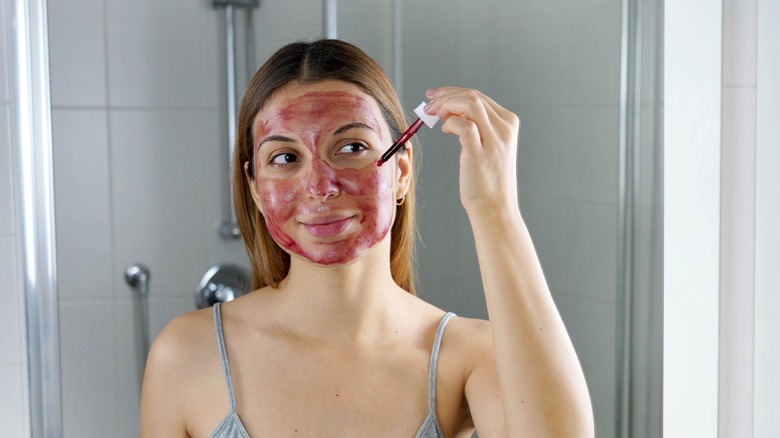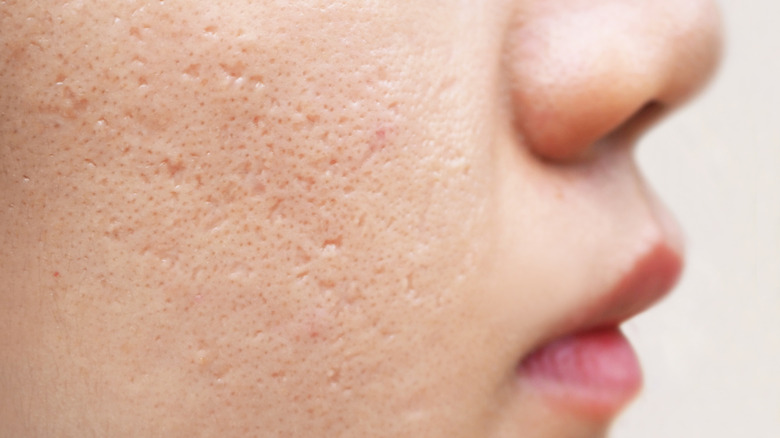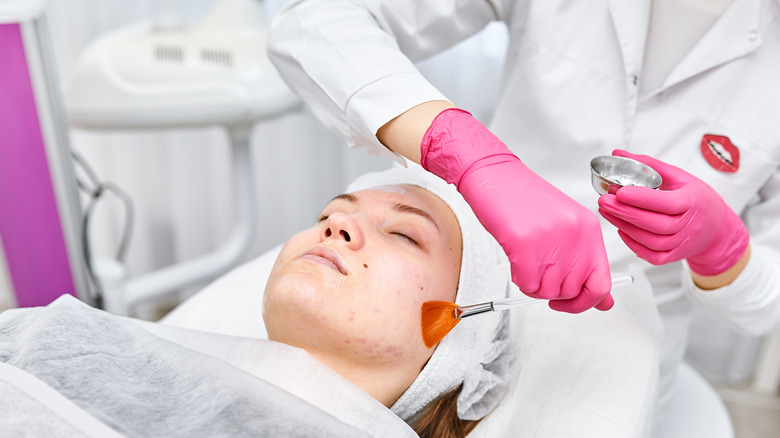Will A Chemical Peel Help Get Rid Of Acne Scars?
Acne is common for many young people, with Yale Medicine reporting that about 85% of teens and young adults between the ages 12 and 24 are affected. However, it's a myth that those unsightly blemishes magically disappear as you age. In fact, 25% of women and 12% of men over 40 still report having acne, which can be caused by a buildup of bacteria, oil, and dead skin cells clogging a pore or from an imbalance in hormones.
Many people have their own tried and tested methods for preventing acne, whether that's through the skincare products they use or the food they eat. But sometimes, it's what happens after acne that's worse than the actual bump. When acne is severe enough, it can cause scarring on the face, which can cause the skin to have an uneven tone or texture. These issues can take longer to heal, especially if you aren't using the right products.
That's where chemical peels come in. These exfoliating products help people maintain smooth, even skin, and they can help get rid of acne scars. However, it's not a one-size-fits-all practice.
What causes acne scars
Even with the best skincare routine, you can still be prone to acne. As dead skin cells shed, some can clog pores, and when mixed with bacteria and oil, a pimple can form. Small whiteheads and blackheads usually don't cause scarring. It's the large, red, inflamed acne pustules that usually leave behind marks. That's because the inflammation causes swelling that can break down pore walls and damage skin tissue, according to the Cleaveland Clinic. Depending on the severity of the swelling, the scar can be shallow or deep in the levels of the skin.
There's more than one type of acne scar. The most common types are ice pick, rolling, boxcar, and hypertrophic, Healthline explains. Ice pick scars are wide at the top and narrow as they get deeper into the skin. They form where the skin is thin, like on the forehead or upper cheek. Rolling scars have sloped edges, leading to an uneven appearance of the skin. Boxcar scars have sharp edges that penetrate deep into the skin.
Hypertrophic scars are a little different because they're raised on the skin's surface caused by scar tissue overgrowing in the damaged area. They're not as common on the face as they are on the back, chest, and shoulders. Another common part of the acne healing process is discoloration, known as post-inflammatory hyperpigmentation, which leaves behind dark marks where the pimple was. Each of these can be treated to reduce or remove the scar.
How chemical peels can help
Exfoliation is the best way to treat acne scars. Chemical peels remove damaged skin cells with the use of skin-safe acids that work either on the surface or deep with the skin's layers. By removing damaged or dead skin cells, new ones can grow, which can repair acne scars and discoloration. But what chemical peel you should get depends on the kind of acne you have.
New York City dermatologist Michele S. Green says if you're looking to treat superficial scars, chemical peels that have alpha hydroxy acids and trichloroacetic acid are a great idea. Consider glycolic acid at 30% to 50% to help improve discoloration scarring that doesn't go that deep. You can often find these formulations in skincare products you can purchase yourself.
But for boxcar scars and ice pick scars that go deep into the skin, you may need to see a dermatologist for a deep chemical peel. This treatment goes deeper into the layers of your skin to remove skin cells. However, these deep scars come with a risk of hypo- and hyperpigmentation, so they're not recommended for regular treatment. They're often only done once and are not offered for darker skin tones. Because of the risks and limitations, many patients opt to use light and medium-strength peels over time. They're gentler on the skin and you can see results in a few weeks to months.


